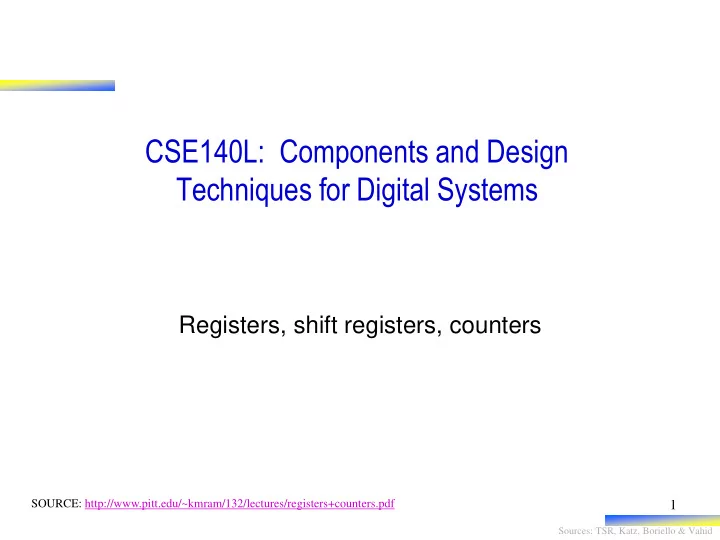

CSE140L: Components and Design Techniques for Digital Systems Registers, shift registers, counters SOURCE: http://www.pitt.edu/~kmram/132/lectures/registers+counters.pdf 1 Sources: TSR, Katz, Boriello & Vahid
D Latch Truth Table CLK R R Q Q D S S Q Q D CLK D D S R Q Q 0 X X 0 0 Q prev Q prev 1 0 1 0 1 0 1 1 1 0 1 0 1 0 Sources: TSR, Katz, Boriello & Vahid
D-Flip Flop • Built using a master D-latch and a servant D-latch • Stores 1 bit of information (either a 0 or a 1) • Samples a new value on each rising edges of the clock (an alternative design can sample on the falling edge) Id D Q(t) Q(t+1) D flip-flop 0 0 0 0 D latch D latch Q ’ D 1 0 1 0 Qs ’ Dm Qm Ds 2 1 0 1 Q Cm Cs Qs 3 1 1 1 master servant rising edges Clk Clk Characteristic Equation Q(t+1) = D(t) 3 Sources: TSR, Katz, Boriello & Vahid
Building blocks with FFs: Basic Register • Register: a sequential component that can store multiple bits • A basic register can be built simply by using multiple D-FFs OUT1 OUT2 OUT3 OUT4 I3 I2 I1 I0 reg(4) D Q D Q D Q D Q Q 3 Q 2 Q 1Q 0 CLK IN1 IN2 IN3 IN4 4 Sources: TSR, Katz, Boriello & Vahid
Register: basic Verilog module Register (D, Clk, Q); input [3:0] D; input Clk; output reg [3:0] Q; always @(posedge Clk) Q <= D; endmodule 5 Sources: TSR, Katz, Boriello & Vahid
Register • A register is a memory device that can be used to store more than one bit of information. • A register is usually realized as several flip-flops with common control signals that control the movement of data to and from the register • Common refers to the property that the control signals apply to all flip-flops in the same way • Load or Store: put new data into the register • Read: retrieve the data stored in the register (usually without changing the stored data • Clear: writes a default value into the register (usually all zeros) • (Read/Write)-Enable: Enables respectively reading from and writing to the register SOURCE: http://www.pitt.edu/~kmram/132/lectures/registers+counters.pdf Sources: TSR, Katz, Boriello & Vahid
Example: register with clear 7 Sources: TSR, Katz, Boriello & Vahid
Synch/Asynch control signals • Control Signals • When they are asserted, they initiate an action in the register • Asynchronous Control Signals cause the action to take place immediately • Synchronous Control Signals must be asserted during a clock assertion to have an effect • “Traditional” control signals: • Load/Store/Write • Read • Clear • Enable • Depending on the functionalities of your register, you might want to design other control signals • Dummy example: a control signal that writes a 0 on all even 8 positions Sources: TSR, Katz, Boriello & Vahid
Example 2: register with load, clear and output enable 9 Sources: TSR, Katz, Boriello & Vahid
Shift registers • A shift register is a register capable of shifting its bits from one FF to the next one • NOTE: do not confuse the shift register with the logic/arithmetic shifter • Is the shift register drawn above a left shifter or a right shifter? 10 Sources: TSR, Katz, Boriello & Vahid
Example: Verilog shift register with load 11 Sources: TSR, Katz, Boriello & Vahid
Example 2: A multifunction shift register with control signals 12 Sources: TSR, Katz, Boriello & Vahid
Counters • A counter is a register capable of incrementing and/or decrementing its contents • More general definition: a register capable of changing its content between a set of possible predefined sequences (this definition accounts for more “fancy” counters) • What other possible control signals you can apply to counters: • Counting up/down • Modulus • … 13 Sources: TSR, Katz, Boriello & Vahid
Example: counter module counter (C, CLR, Q); input C, CLR; output [3:0] Q; reg [3:0] tmp; always @(posedge C or posedge CLR) begin if (CLR) tmp = 4'b0000; else tmp = tmp + 1'b1; end assign Q = tmp; • What is this counter doing? • The CLR signal is synchronous or asynchronous? 14 Sources: TSR, Katz, Boriello & Vahid
Example 2: counter module counter (C, S, Q); input C, S; output [3:0] Q; reg [3:0] tmp; always @(posedge C) begin if (S) tmp = 4'b1111; else tmp = tmp - 1'b1; end assign Q = tmp; endmodule • What is this counter doing? • The set (S) signal is synchronous or asynchronous? 15 Sources: TSR, Katz, Boriello & Vahid
Recommend
More recommend